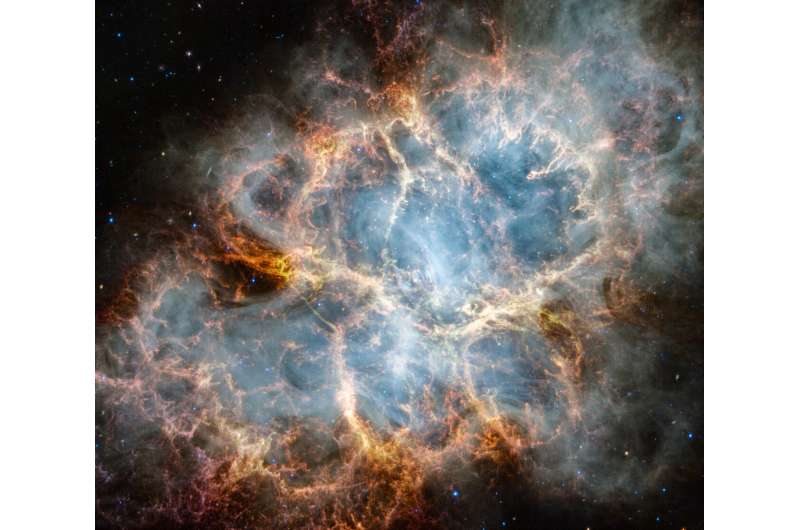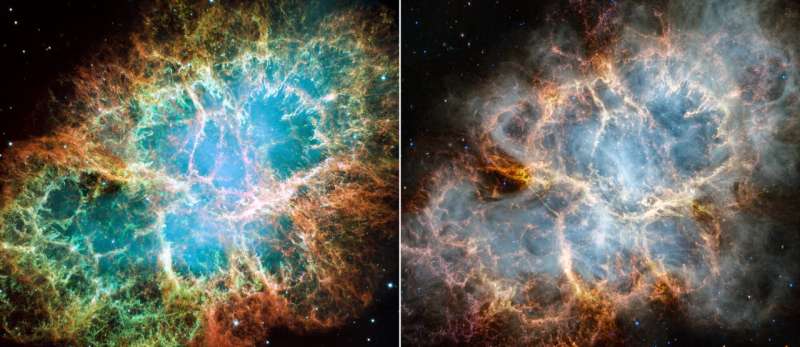This article has been reviewed according to Science X's editorial process and policies. Editors have highlighted the following attributes while ensuring the content's credibility:
fact-checked
trusted source
proofread
The Crab Nebula seen in new light by NASA's Webb

Exquisite, never-before-seen details help unravel the supernova remnant's puzzling history.
NASA's James Webb Space Telescope has gazed at the Crab Nebula, a supernova remnant located 6,500 light-years away in the constellation Taurus. Since the recording of this energetic event in 1054 C.E. by 11th-century astronomers, the Crab Nebula has continued to draw attention and additional study as scientists seek to understand the conditions, behavior, and after-effects of supernovae through thorough study of the Crab, a relatively nearby example.
Using Webb's NIRCam (Near-Infrared Camera) and MIRI (Mid-Infrared Instrument), a team led by Tea Temim at Princeton University is searching for answers about the Crab Nebula's origins.
"Webb's sensitivity and spatial resolution allow us to accurately determine the composition of the ejected material, particularly the content of iron and nickel, which may reveal what type of explosion produced the Crab Nebula," explained Temim.
At first glance, the general shape of the supernova remnant is similar to the optical wavelength image released in 2005 from NASA's Hubble Space Telescope: In Webb's infrared observation, a crisp, cage-like structure of fluffy gaseous filaments is shown in red-orange. However, in the central regions, emission from dust grains (yellow-white and green) is mapped out by Webb for the first time.

Additional aspects of the inner workings of the Crab Nebula become more prominent and are seen in greater detail in the infrared light captured by Webb. In particular, Webb highlights what is known as synchrotron radiation: emission produced from charged particles, like electrons, moving around magnetic field lines at relativistic speeds. The radiation appears here as milky smoke-like material throughout the majority of the Crab Nebula's interior.
This feature is a product of the nebula's pulsar, a rapidly rotating neutron star. The pulsar's strong magnetic field accelerates particles to extremely high speeds and causes them to emit radiation as they wind around magnetic field lines. Though emitted across the electromagnetic spectrum, the synchrotron radiation is seen in unprecedented detail with Webb's NIRCam instrument.
To locate the Crab Nebula's pulsar heart, trace the wisps that follow a circular ripple-like pattern in the middle to the bright white dot in the center. Farther out from the core, follow the thin white ribbons of the radiation. The curvy wisps are closely grouped together, outlining the structure of the pulsar's magnetic field, which sculpts and shapes the nebula.
At center left and right, the white material curves sharply inward from the filamentary dust cage's edges and goes toward the neutron star's location, as if the waist of the nebula is pinched. This abrupt slimming may be caused by the confinement of the supernova wind's expansion by a belt of dense gas.
The wind produced by the pulsar heart continues to push the shell of gas and dust outward at a rapid pace. Among the remnant's interior, yellow-white and green mottled filaments form large-scale loop-like structures, which represent areas where dust grains reside.
The search for answers about the Crab Nebula's past continues as astronomers further analyze the Webb data and consult previous observations of the remnant taken by other telescopes. Scientists will have newer Hubble data to review within the next year or so from the telescope's reimaging of the supernova remnant. This will mark Hubble's first look at emission lines from the Crab Nebula in over 20 years, and will enable astronomers to more accurately compare Webb and Hubble's findings.
Provided by NASA





















